Galvanized by Dostoevsky’s critique of utopian thinking that predicted many of the horrors of 20th-century totalitarianism, Green’s artistic practice satirizes the hyper-competition and idyllic sentiments of contemporary society. The South Korean artist forces us to confront some of the more uncomfortable tendencies of modernity that push individuals to belligerent competition and loss of their ‘own’ selves.
His movements are expressions of a sophisticated and impulsive technique. Thick and energetic oils, often straight from the tube, are coupled with palette knife strokes cutting the canvas impetuously. These stronger coatings are contrasted with other more delicate linear marks drawn on the canvas with oil sticks. Sizable canvas cloth is also preserved and shows in large areas. These are not random choices in Green’s artistic practice; they are instead symbols of a calculated maneuver to draw the audience’s attention to elements of absence and presence, strength and weakness, all coexisting as notes of a harmonic symphony. Audiences are left to surgically analyze the narratives of his paintings, to discover their inner meanings, to evaluate what he is trying to convey.
Green’s innovative practice is an emotional synesthesia, where sensory stimuli are involuntarily associated with an emotional response not yet fully controlled by this artist. His persona is struggling to be revealed in its entirety, and this is visible in the restiveness and agitation of his technique, also representative of the general struggle of emerging artists trying to succeed in the competitive arts field.
Green’s paintings Poaching and The Nasty Politician can be described as intense and visually captivating. In both paintings, layers of bold, textured, and colorful strokes create evocative ambiguous representations of what the artist sees in this world. In Poaching, the fish’s life is sucked out by a shark — the weak being eaten by those on top of the food chain. In The Nasty Politician, the ambiguous figure gives the audience a hollow and evil smile, as they are subjects of his dark will. His inspiration comes from his life and corporate experience as a Designer in South Korea, one of the most competitive countries in the world, where the artist always strived to be an eater rather than being eaten.
Similar to Tolstoy’s Anna Karenina and Jean-Michel Basquiat’s masterpiece Defacement, the audience is asked to engage in a critique and resistance to societal systems oppressing individuals. Peer-to-peer competition, corruption, and inequality are key messages Green is striving to convey. These concepts are relevant to modern art discourse as they are significant for those living within modern societies themselves. Audiences are invited to reflect upon the loss of their individuality and their passive acceptance of imposed societal norms. His practice invites humanity to ‘cease being so focused on perceptions, those in society overlook their own inadequacies,’ while inspiring them to be the creators of their own triumph. Green’s artistic practice is violently beautiful, and there is no doubt it will bring a positive impact on the contemporary Visual Arts field.
Biography
Green (Yong Woon Park) is a South Korean artist based in London. After studying Fine Art and Environmental Design in South Korea, he worked for Chang-Jo Architecture as an Environmental Designer and funded his own Design Studio. Dissatisfied with corporate life and unable to ignore his drive to express himself through painting, he decided to move to London, where in 2022 he obtained an MA Degree in Fine Art: Painting at Camberwell College of Arts, UAL. Green is currently painting in his studio at the Bow Arts Lakeside Centre in London. In 2023, he was selected by Chila Burman to be part of the exhibition Bring your Light at the Nunnery Gallery. He also displayed his work at the Surging Silence exhibition at the Hypha Studios. In 2024, he was part of a trio-exhibition at Four Corners in London called A Mighty Gust. Green is enthusiastic about politics and expressing his critical opinion about dystopian societies.
Website
 Photographed by Marie-Nelika Clerc
Photographed by Marie-Nelika Clerc
Your art is deeply rooted in your emotions and experiences in South Korea, particularly the societal pressures you describe. How has your move to London influenced your artistic practice and your expression of these emotions?
Moving to London has been a key influence in my life and in expanding and expressing my artistic practice focused on a strong criticism of inequality and peer pressure. Similarly to South Korea, the UK is a social class society where political and/or socio-economic status dictates the class each citizen fits into. High social status and wealth belong to a few in these class systems, where the rich dominate over the poor. In this environment, it seems natural to me to express my anger, regret, and disappointment toward the treatment of the latter group through violent, aggressive, and colorful oil paint strokes. I purposely leave large empty areas of raw canvas in the hope that audiences will use it as a vehicle to find themselves and reflect upon acceptance or critique of societal norms. The subjects used (for instance satirical figures, natural creatures, and Korean traditional imagery) are representative of my criticism toward the injustices and inequalities I see and experience in my daily life in London. In this country, the rise of economic inequality, the increase of homelessness, and the struggle of ethnic minorities and those differing from the “norm” are key concepts inspiring the narratives of my paintings. Yet, unlike South Korea (still a homogenous society for the most part), London is also a positive forum to express my own individual persona as an artist, while having the opportunity to access London’s diversity. In this city, I have the chance to meet people from different walks of life, learning from their experiences and cultures — these are all elements inspiring my art. Moreover, here I have fewer inhibitions; I am not required to abide by the traditional set of rules that Korean society imposes on me. I can be myself; I can express my feelings of anger and regret freely while denouncing what makes both societies alike.
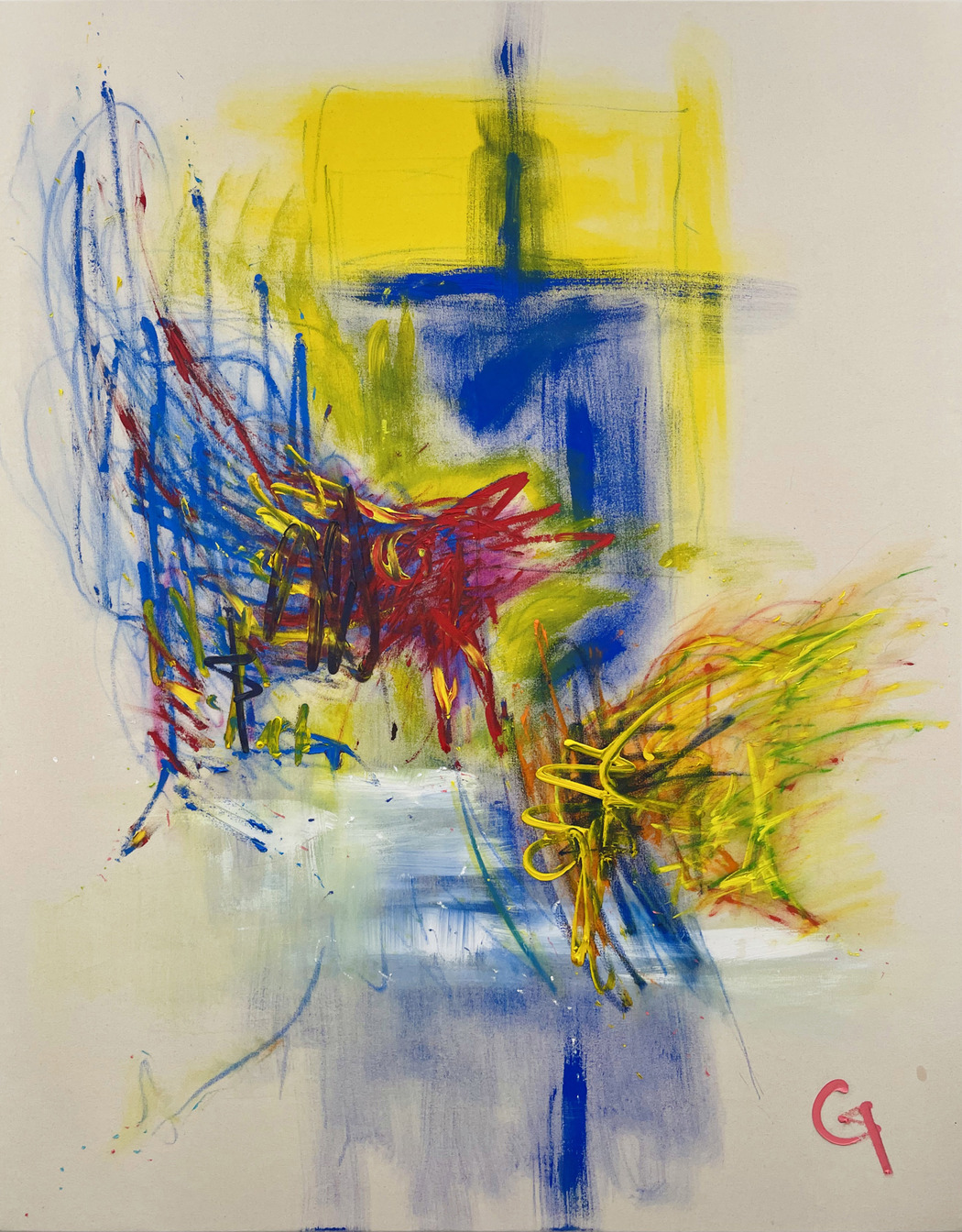 Green (Yong Woon Park) | Nagging | 2023
Green (Yong Woon Park) | Nagging | 2023
You mention that your artworks are an “emotional outcry” against societal issues like competitiveness, inequality, and peer pressure. How do you think your art speaks to audiences facing similar issues globally?
My art message is not particularly subtle; the meaning is often right there in the titles of my paintings. My art is an anti-capitalist narrative that depicts the wealthy as parasites, sadists, and indifferent to the working class, who are, quite literally, struggling to keep their heads above water. Nowadays, our global economies are collapsing, wars and conflicts are raging, and the gap between the rich and the poor is becoming wider and wider. In this environment, the least fortunate fight to stay afloat, pushing each other down. My art aims to represent their voices, their struggles to survive, and to denounce the parasitic lifestyle of the corrupted in our societies. Through my art, I would like to alert audiences to the danger of capitalist societies, and how through their own actions, they can be the drivers of positive change, bringing equality and equity among us all.
The use of vibrant colors, harsh brush strokes, and thick textures plays a key role in your work. Could you elaborate on how these visual elements reflect your internal experiences and personality?
I have a burning and honest personality. Texture represents my anxiety, restlessness, and agitation; feelings that drive the hand that builds the ‘thickness’ on my canvas. I balance that with the use of vivid colors applied after carefully pre-imagined color compositions. Color represents my softer side, the gentler sentiment of innocence and love for beauty I have within myself. I always feel in a rush, in need to complete my paintings in one night, and this is visible in the way I use colors, sometimes applied straight from the tube. This dichotomy between ‘thickness’ and ‘brightness,’ ‘harshness’ and ‘softness’ is truly representative of my multi-faceted personality. I am curious, creative, and open to learning and new experiences. But I am also emotional and impetuous as the world is oppressing me.
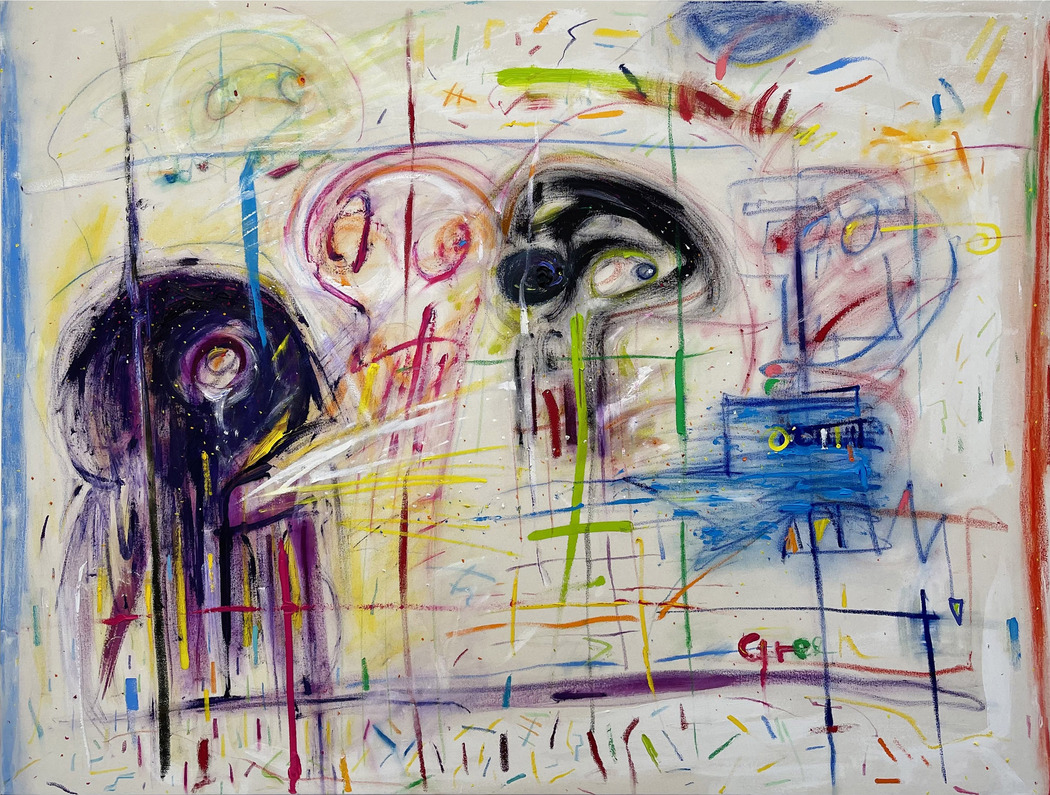 Green (Yong Woon Park) | Walk on Eggshells | 2023
Green (Yong Woon Park) | Walk on Eggshells | 2023
You integrate elements of Korean folklore and mythology into your pieces. How do these traditional elements interact with the modern societal issues you’re addressing in your art?
As a South Korean artist, I feel compelled to bring elements of my heritage into my artworks. These are deeply rooted in my understanding of the arts and how I see the world around me. For instance, I sometimes paint subjects wearing traditional Korean masks (also known as ‘gamyeon’) as a satire against modern pressure to abide by collective unattainable standards. The powerful are sometimes represented as wearing these masks, making fun of all of us, of our need to be all ‘pretty’ and ‘successful.’ Moreover, the use of traditional Korean Goblins (or ‘Dokkaebi’) in some of my paintings is representative of good fortune and prosperity for my audiences. I encourage them to be happy with their own lives without feeling pressured or obliged to fight for the scraps that modern societies have to offer. On the other hand, as ambiguity is within the contrasting nature of a painter, I use Goblins to depict the higher classes bringing bad omens to humanity, as they are the few who want to be the sole beneficiaries of all resources available to all of us instead.
You’ve mentioned that you feel like a bystander in life, a feeling many can relate to in today’s fast-paced society. How do you think art can help individuals reclaim their voices or identities in such an environment?
As an artist, the direct intention of my artworks is to encourage individuals to release themselves from ‘hibernation,’ from passively accepting what society dictates, and to release their uniqueness. I aim to encourage them to find their own voices, to reflect upon what’s right and wrong in their lives and in the society they live in. I would like humanity as a whole to think about their actions and the impact these have on the wider society. I would like my audiences to ask themselves questions such as: ‘What am I doing here?’, ‘Why do we fight?’, ‘Why do we compete?’, ‘In what kind of world would I like to live in?’, ‘How can I express myself fully?’ and ultimately ‘How can I help those less fortunate?’, ‘What can I do to change this world?’ Nowadays, people rarely begin processes of self-reflection; they are more concentrated on the way their character and life are shown and evaluated by others — they all become bystanders focused on meeting the expectations of the ‘whole,’ rather than expressing their own identities and saying ‘no’ to injustices. My artworks are vehicles for self-reflection, to foster personal expression and positive change. I was able to liberate myself through painting, and this is visible in my frantic technique characterized by an intense expressive subjectivity. I hope that others can liberate and express their full selves via my stimulation.
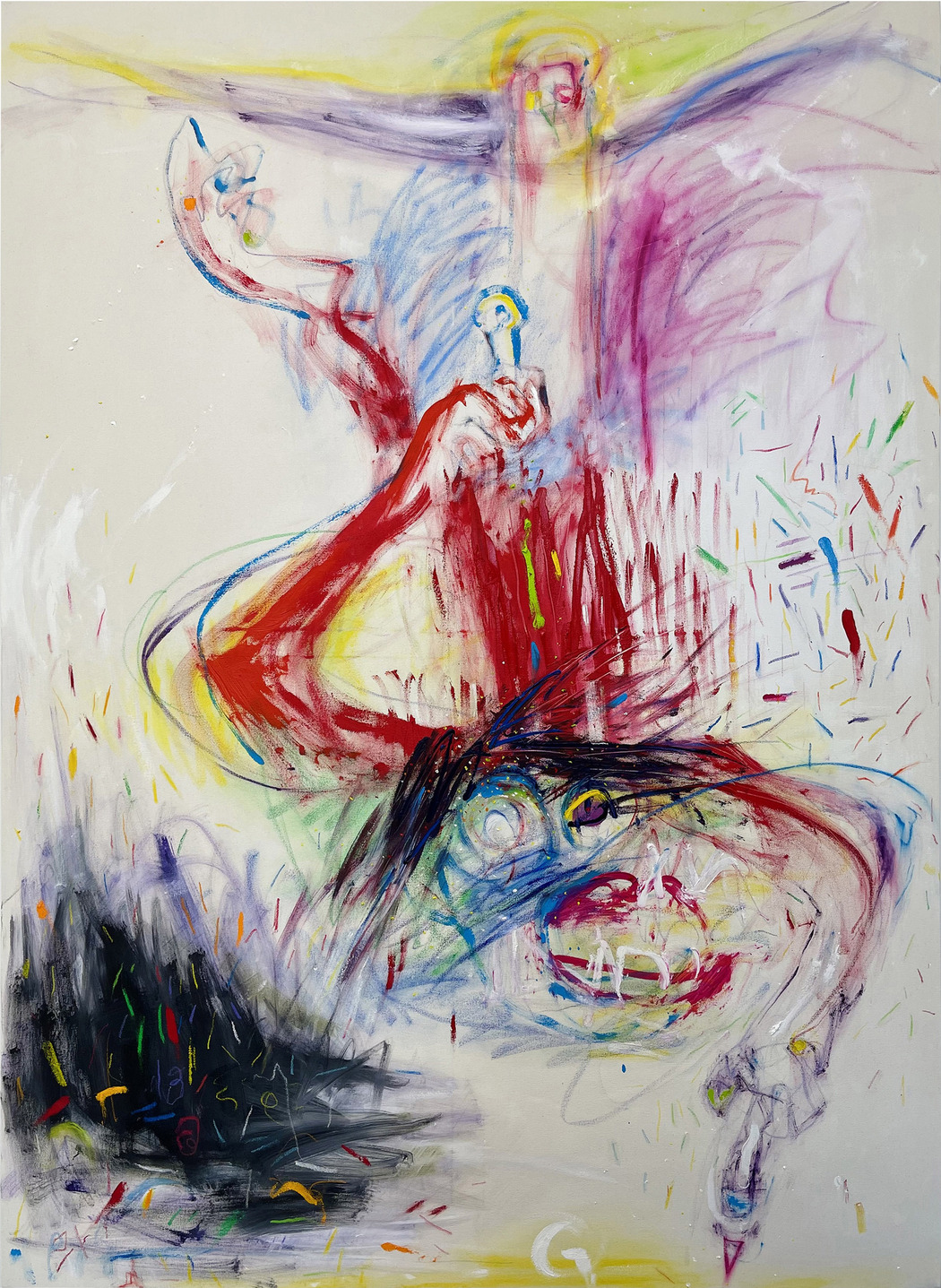 Green (Yong Woon Park) | Brave Monkey | 2023
Green (Yong Woon Park) | Brave Monkey | 2023
Your work often critiques the status quo, particularly in societies that you believe attempt to shape individuals into “particles of their rotten core.” What are your hopes for how your audience will interpret and respond to these themes?
I would like my audiences to ponder the huge divide between the upper and lower classes and how inescapable poverty can be. Similar to the great neo-expressionism artists who often asked audiences to explore deep emotional and psychological themes, such as personal experiences, societal issues, and the human condition, I hope that my audiences will be able to reflect upon their lives and the individual contributions they can make to foster equity and equality in our world. I would like to inspire more people to use their voices in condemnation of racism, discrimination, oppression, economic inequality, and unfair competitiveness — these are idiosyncrasies of contemporary societies. These are elements forming the contemporary status quo, and these are influences that make people passive and indirectly willing ‘particles of its rotten core.’
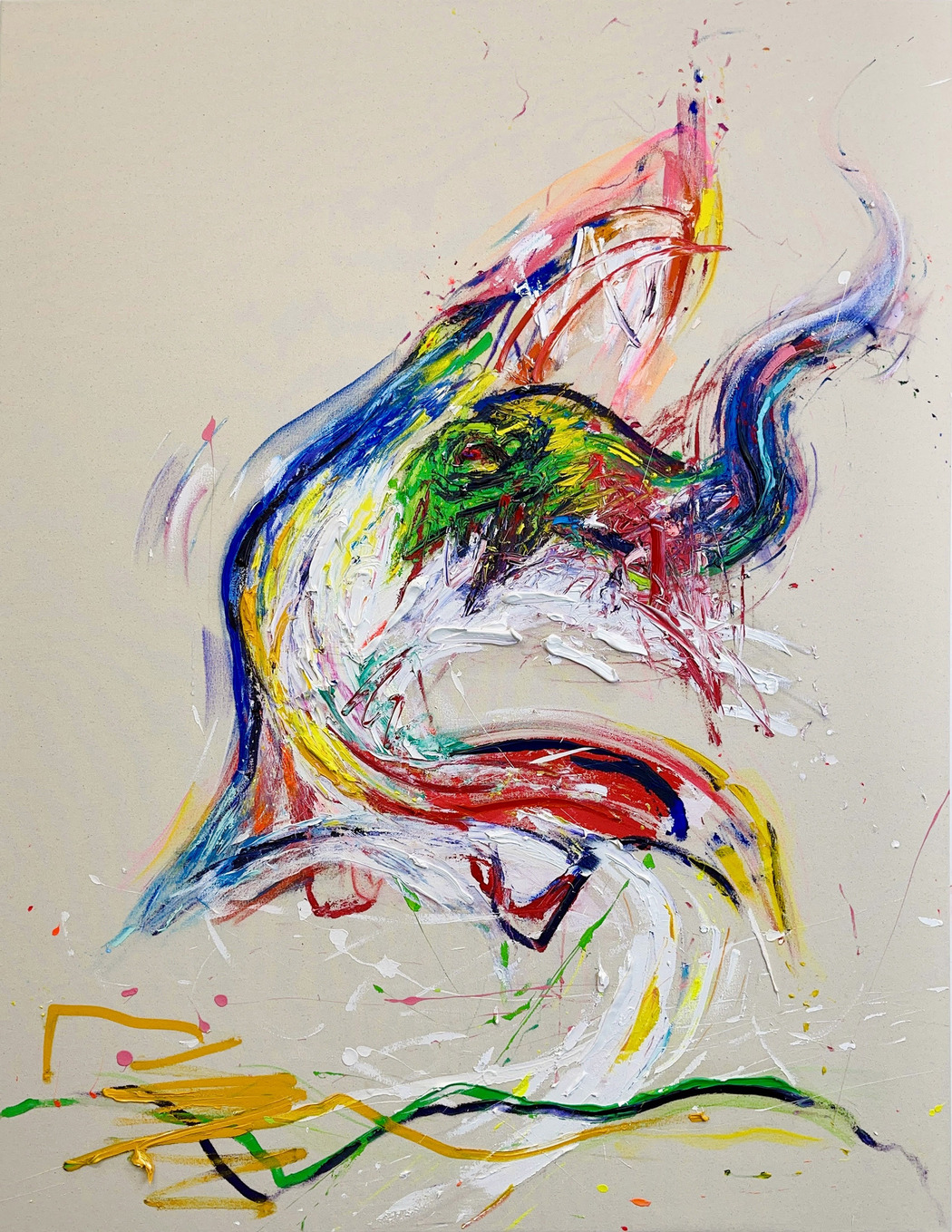 Green (Yong Woon Park) | Poaching | 2024
Green (Yong Woon Park) | Poaching | 2024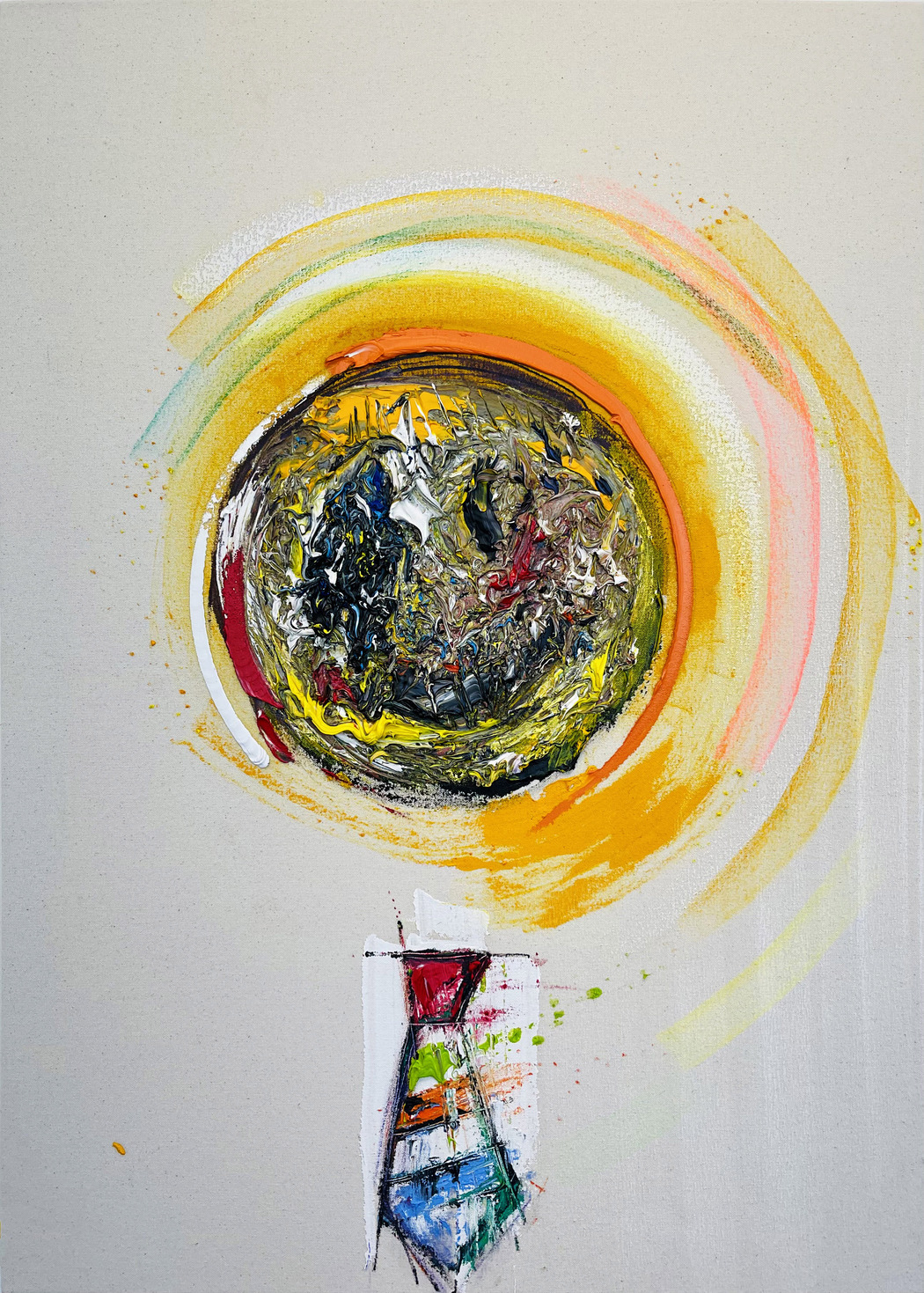 Green (Yong Woon Park) | The Nasty Politician | 2024
Green (Yong Woon Park) | The Nasty Politician | 2024 Photographed by Marie-Nelika Clerc
Photographed by Marie-Nelika Clerc Green (Yong Woon Park) | Nagging | 2023
Green (Yong Woon Park) | Nagging | 2023 Green (Yong Woon Park) | Walk on Eggshells | 2023
Green (Yong Woon Park) | Walk on Eggshells | 2023 Green (Yong Woon Park) | Brave Monkey | 2023
Green (Yong Woon Park) | Brave Monkey | 2023
Madeline Rende
What a suprising discover. This artist is phenomenal, especially as it brings fresh new imagery to describe such a contemporary topic. I like his use of colours and narratives. His view of contemporary societies appeals to the world’s sentiment seeking peace and equality. I will definitely check him out!